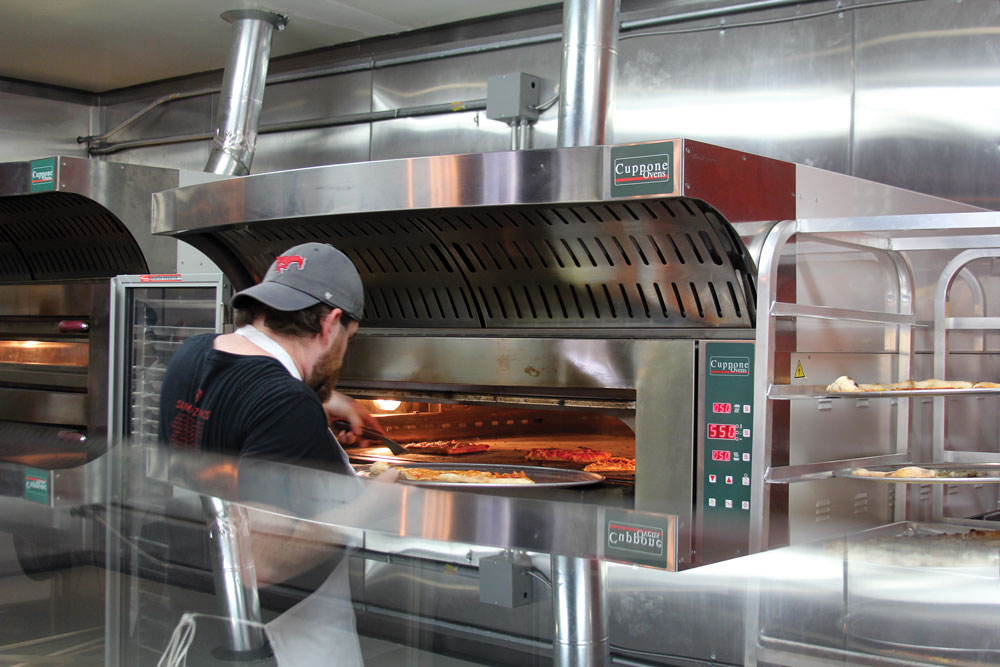Pizza makers don’t just depend on their ovens to make money—it’s practically a love affair, a relationship based on tender care, patience and understanding. Pizzaioli know their ovens like they know their wives or husbands. But ovens, like spouses, don’t live forever. And some ovens just don’t deserve you.
Fortunately, unlike most people, pizza ovens are getting better and better all the time. If you’re in the market for a new oven, the market won’t let you down. There are various styles for various tastes and needs—some are plain but ever-faithful, while some are high-maintenance but sexy as heck. Of course, none of them are cheap. Before you rush into a long-term commitment, here’s what you need to know.

Conveyor Ovens
Pros: Conveyor ovens are widely used for a reason. Because this oven type’s speed and airflow are fixed, every pie is baked the same, ensuring product consistency. They’re also essentially idiot-proof, ensuring fast workflow in the kitchen during busy hours. They don’t require an experienced, keen-eyed pizzaiolo to peel them in, pull them out and move them around to find the sweet spots. You can place multiple (similar) pies side by side on the line and watch them come out perfectly baked on the other end. They’re assembly-line marvels that just about anyone can learn to use in little time. Finally, they preheat quickly, hold their temperature well and cool down quickly. How sexy is that?
Cons: A faulty conveyor belt can throw everything out of whack. If there’s a malfunction, the pizzas won’t move along and everything can go into shutdown mode faster than the U.S. government. Also, remember that you must do your part to ensure consistency—with conveyor ovens, it’s hard to add or subtract a minute to the baking time of any one pizza to get it just right.
Deck Ovens
Pros: You have to play your deck oven a bit like a delicately tuned musical instrument, but the result is pizza with amazing flavor. The deck itself may be made with ceramic tiles, large bricks or sections of stone. These surfaces bake the bottom crust differently from a conveyor oven, and, since they’re usually coated with flour or cornmeal to prevent sticking, the crust comes out with a distinctive and wondrous texture, appearance and taste. Stone decks yield a nice, crispy crust, absorbing the oils and moisture released from the pizza to ensure a drier final product. Tiles, although not as thick as stone, also absorb oils and moisture, and they’re less expensive.
Cons: Deck ovens tend to release heat as the doors are opened and closed and pizzas are inserted, shuffled and removed. They also require a skilled operator who pays close attention and knows how to consistently get the optimal bake for each pie.
Rotating Deck Ovens
Pros: This version of a deck oven rotates the pizzas for you, reducing the amount of skill required for your cooks. Since it’s not necessary to open and close the doors constantly and shuffle the pies by hand, less heat escapes and less energy is consumed.
Cons: Your cook still needs some skill to operate the oven, but not as much compared to running a traditional deck oven.

Wood-burning or Coal-burning Ovens
Pros: Perfect for dine-in operations, these ovens look gorgeous in your restaurant and create ambience—warm fire, cozy table, delicious food—that your customers won’t soon forget. They also deliver unique flavor and, because they can achieve very high temperatures (up to 900°), bake the pie quickly. Wood generates a gentle, moist heat and imparts a unique, smoky flavor while maintaining the crunch of your toppings. Coal ovens are almost synonymous with New York pizza. They cook at even higher temperatures than wood-fired ovens, reaching up to 1,000°, and produce a signature char, a crispy crust and a chewy interior. As versatile as they are powerful, these ovens can be used to bake many other menu items, including breads, roasted veggies and meats, and sandwiches. Finally, these ovens don’t require electricity or gas to operate, although you still have to pay for the wood or coal.
Cons: Pizza ovens of any kind don’t come cheap, but high-quality wood-burning and coal-burning ovens are a major investment. They take up a lot of space, and becoming a “keeper of the flame” requires a high level of expertise. Every oven is unique, and the quality of your pizzas will depend heavily on the skills of your oven tender. These ovens can also take a while to heat up to baking temperature and need to be fed continuously, whether the restaurant is open for business or not. Finally, some states and municipalities regulate the installation and use of these ovens—make sure you know the law before you fire up your oven.
Rick Hynum is PMQ’s editor in chief.















